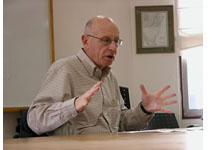|
By Ira Sharkansky
 JERUSALEM—This part of the Middle East has long been a place of exciting ideas. Chosen People, Promised Land, and Holy City have motivated Jews for more than two millennia. Nakba has served Palestinians for 60 years. Settlements arouse both Israelis and anti-Israelis. Some see them as part of salvation, and others as the essence of sin. JERUSALEM—This part of the Middle East has long been a place of exciting ideas. Chosen People, Promised Land, and Holy City have motivated Jews for more than two millennia. Nakba has served Palestinians for 60 years. Settlements arouse both Israelis and anti-Israelis. Some see them as part of salvation, and others as the essence of sin.
Hyperbole may be the regional disease, or at least one of the elements preventing the calm that we envy for Scandinavia and New Zealand.
Way down the list from Chosen People, Promised Land, Holy City, or Nakba, but still warm to the touch is a note distributed by the Adelson Institute for Strategic Studies. David Keyes begins with the statement that "Saddam Hussein killed more Arabs and Muslims than any other Middle Eastern leader in recent history."
He goes on to write that "Saddam . . . imposed order in Iraq. . . . Prizing stability over liberty is the root of so many of the region’s ills."
There is more here than at first glance.
The Adelson Institute is part of the Shalem Center, one of the organizations funded by politically active American Jews. Shalem's dominant line is somewhere on the right of Israeli and American politics. Its founders bowed in the direction of Meir Kahane. They publish Hebrew translations of conservative classics (Milton Friedman, F. A. Hayek, Edmund Burke), and support writers who express their point of view.
Natan Sharansky was the founding chairman of the Adelson Institute. His book, The Case for Democracy: The Power of Freedom to Overcome Tyranny and Terror, was part of George W. Bush's explanation for his campaign against Saddam.
What David Keyes says about the deaths associated with Saddam may be correct, but perhaps not. The issue is
Go to the top of next column
|
|
contentious, and important in judging what has resulted from his removal.
The number of people killed during Saddam's reign may have been as high as two million. To reach that figure, however, it is necessary to include estimates of 750,000 Iranians killed during the Iran-Iraq war, 200,000 Iraqis killed during the 1991 Gulf War, and 500,000 Iraqi children who may have died as a result of international trade sanctions.
Whatever the number of Iraqi deaths that might be linked to Saddam's reign, it may not be all that much different from the number associated with the violence that got underway with Bush's invasion of 2003.
A lengthy article about Iraqi deaths from the Guardian of July, 2008 admits that "the exact . . . toll remains a mystery." Estimates range from under 100,000 to nearly 1.5 million. "Inevitably, the issue has become a political football, with the Bush administration, the British government and other supporters of the US-led occupation seizing on the lowest estimates and opponents on the highest."
The figure of 1.5 million, if true, would be larger than estimates of Iraqis killed by Saddam, leaving out Iranians who died in the war of the 1980s.
The issue is greater than the murky subject of casualties. Many view the ouster and execution of Saddam Hussein as a benefit, but the balance of costs and benefits is less clear. Beyond the costs as measured in dead Iraqis, plus Americans and others, is the spur to Islamic extremism, hatred of Americans, Jews and other westerners; what the ongoing violence may contribute to Iranian nuclear efforts; the resurgence of Taliban in Afghanistan; and the spread of instability to Pakistan. For some, Bush's doubtful crusade produced the benefit of political change in the United States. For others, President Obama's concern to engage with Iran and other Muslims, and increase the military effort in Afghanistan should be counted among the costs of what Bush initiated.
Was the world, and even Iraq, better off with Saddam Hussein? His cruelty was reprehensible, but stabilizing. We do not yet know the final death toll, the nature of the new Iraq, or the effects coming from its transition.
|
|

